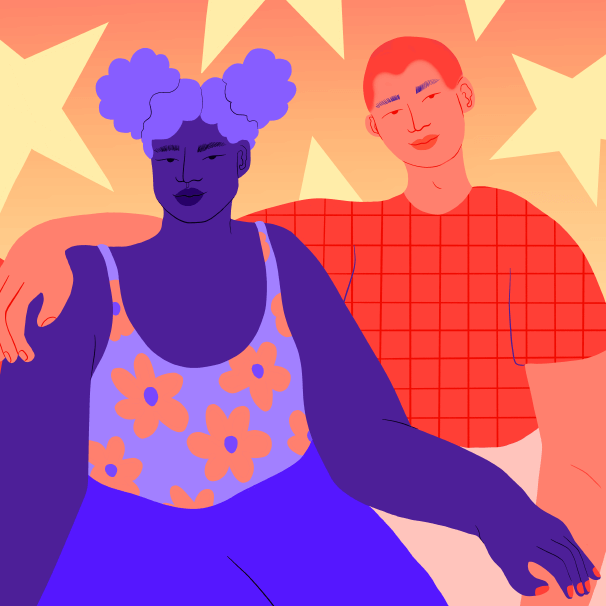As the national conversation around racial justice and equality for Black people grows in volume and scope, many Black LGBTQ young people are facing difficult conversations with people who are uninformed about race, queer identities, or the intersection of both. Intersectional conversations can take a variety of forms. Some are engaging their white friends for the first time about how being Black impacts their experience in LGBTQ spaces, and others are opening up about the nuances of their queer experiences in Black spaces. For people who hold multiple marginalized identities, it can sometimes feel overwhelming to explore the layers of these conversations with others — especially those whose lived experiences are different.

If you’re considering engaging with people who identify as non-Black in your life about your identities, it’s important to remember that the process of having difficult conversations does not begin or end with the discussion itself. It is essential to consider your well-being and safety at each step in the journey. Here are some approaches to consider before, during, and after a difficult conversation to make sure the dialogue — and your mental health — stays safe.
BEFORE:
Preparing yourself for intersectional conversations
Preparing for a tough conversation about identity can improve your communication skills and increase your confidence. While you cannot control how someone may respond to you, going into a discussion with some understanding of what you think, how you feel, and what you hope will come from it can help you manage your expectations. After thinking it through, you may decide that you no longer want to have the conversation, and that’s okay.
To anchor yourself going into these discussions, consider these questions:
- What is your motivation for having the conversation?
- What is your degree of comfort with talking about race, police brutality, and white supremacy?
- How does your experience as an LGBTQ person inform your point of view?
- What aspects of the subject do you find challenging?
- What research might help you in communicating your viewpoint?
- What are your assumptions about the other person’s understanding?
- What environment and time do you think will be the safest to ask someone to engage in a conversation with you?
- What are the ground rules for the conversation? Examples include: one person speaks at a time, using “I” statements to communicate from your own experiences, and not making assumptions about others’ experiences.
- What is your plan if the conversation reaches a point where you no longer feel safe? This can include making alternative arrangements for housing, food, or transportation in advance.
- Do you need help organizing your thoughts? If so, try reaching out to someone you trust and ask them to practice. You can also have a conversation with yourself, either out loud or by writing it down.
Thinking through these questions in advance can lay the foundation for a productive conversation. If you would find it helpful to have moral support throughout the conversation, invite someone you both know to be present during the discussion.
If this is your first time discussing your sexual orientation or gender identity with them, you may want to reference The Trevor Project’s Coming Out: A Handbook for LGBTQ Young People and our Guide to Being an Ally to Transgender and Nonbinary Youth.
DURING:
Focus on your experience
Upon entering the conversation, consider communicating any ground rules that might help to create a safe space for you to express yourself. If these ground rules are not respected, or the discussion has reached a point where it is no longer productive or safe for your well-being, consider putting your safety plan into action and ending the conversation.
As the conversation plays out, you may fundamentally disagree on certain subjective ideas. Depending on your goal for the conversation, that can be healthy and conducive to learning from each other. But remember: you are the expert about your experience, and they’re the expert about theirs. If someone questions or denies realities of your Black or LGBTQ experience, that is in no way a reflection of the validity of your experience. Two differing experiences can both be true and valid at the same time, even among people who share similar identities.
If the discussion veers off course, or if the other person steers the conversation off-topic, remember your goals and try to return their attention back to the original topic. Or, you can end the conversation if you wish. Remember, this discussion is a choice, not an obligation.
When making your points, try to be clear and use examples when possible. It’s always helpful to be an active and engaged listener when the other person is speaking. At different points in the conversation, you may feel a variety of emotions — remember to breathe! This range of emotions is normal, and it’s healthy as long as you feel safe.
A productive conversation about lived experiences should feel less like a debate than an exchange of ideas. The important thing is that one or both of you feels more informed, empathetic, or seen as the discussion ends. It’s okay to end the conversation without it feeling “complete” — as with many conversations around identity, this will just be the beginning of a long process of understanding. Some conversations may not feel “productive” in the moment, but after reflection, you may realize that they were actually helpful. Don’t put pressure on yourself to make sure that the conversation was “effective” — you are doing the best that you can!
AFTER:
Reflect on the outcome
Leaving these conversations — even if they have gone well — may have you feeling emotionally and mentally exhausted. Try to create space to decompress after the chat by practicing whatever self-care you need at that moment.
When you’re ready, ask yourself the following questions to help you reflect on the discussion:
How do you feel after having the conversation? Do you feel more or less understood? Hopeful? Frustrated? Taking stock of these emotions is a key first step in deciding if and how you would approach a similar conversation again.

- How did the actual conversation compare to the goals you set beforehand?
- Were you able to successfully follow the boundaries of the conversation you established beforehand?
- What do you wish you would have talked about that you didn’t?
- How do you think you can best follow up to explore the conversation further?
After you’ve had time to reflect, allow this experience to inform future intersectional conversations. Modeling this approach to these difficult discussions will help others approach intersectionality in their lived experiences, and have a positive ripple effect.
For additional ways to care for yourself as a Black LGBTQ young person or to learn how you can support Black LGBTQ youth, check out our article: Supporting Black LGBTQ Youth Mental Health.
If you need support at any point, The Trevor Project is here for you, 24/7, and for free. Visit TheTrevorProject.org/Help any time to connect to a trained crisis counselor via phone, chat, or text.
Adapted from a Trevor blog post by Kendra Gaunt (she/they)
If you’re not Black, but you are interested in how to have conversations about the intersection of race and LGBTQ identities, here’s how to do so while maintaining active and authentic allyship:
- Do your research. Though you may think that asking your Black friends to share their lived experience is creating space for them, it is not the job of Black people to educate you on the racial injustices they face. Proactively seek out resources that allow you to engage in meaningful discussions with Black people on their lived experiences, so that you can fill in the gaps towards understanding the perspectives of LGBTQ+ people of color.
- Get uncomfortable. At certain points in the conversation, you may be told you are wrong, or even that your opinion is harmful. This may make you feel uncomfortable, and it’s okay to acknowledge that and learn from the experience. This work is required as you learn how to be an ally, and unlearn some of the assumptions and biases you hold about race.
- Hold yourself accountable. Everyone has conscious and unconscious bias. A big part of being an ally is examining how yours creates or reinforces harmful conditions for Black people. With this knowledge and understanding, consider the role that you or anyone from your community plays in shaping the lived experience of Black people.
- Listen. Open yourself up to understanding intersectional perspectives without the desire to be heard. When someone approaches you to have a conversation regarding race and how that intersects with their other identities, they are coming from a vulnerable place. Respect their experience even if their perspectives do not align with your own.
- Take action. Think about the ways you can use your privilege, personal platform, money, time, and access to actively support all Black people. Use your voice to uplift the voices of Black people, educate others, support Black businesses, creators, and organizers. And don’t forget to vote!

About the illustrator:
Shanée Benjamin (she/her) is an illustrator from Brooklyn.
Help us continue to provide 24/7 support to LGBTQ+ young people and empower allies to deepen their commitment through advocacy, education, and affirming content.


